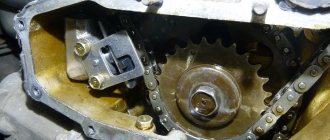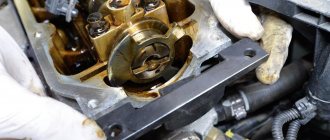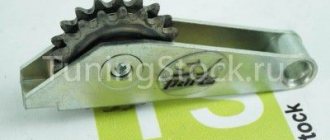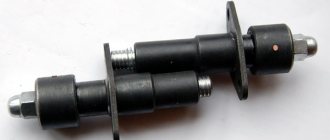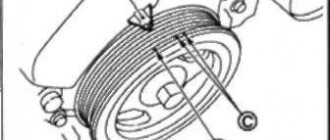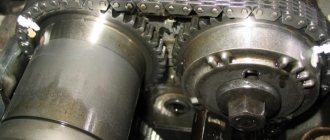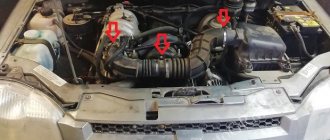Modern cars use two types of transmission of torque from the timing mechanism to the crankshaft. This is a belt and chain design. The second option is more reliable and durable, however, untimely maintenance and repairs can lead to the device operating too noisily. Chain tensioners, which are equipped with all timing kits, allow you to correct the transmission condition.
Purpose
The mechanism in question ensures the normal operation of the chain and the entire drive. The unit is easy to maintain and simple in design. The tension is carried out under the influence of a spring or oil in the working rod of the device. The engine chain tensioner is a fairly reliable element and rarely fails. However, if extraneous noise is heard, it is necessary to check its condition and, if necessary, replace it.
Ignoring this problem leads to the chain weakening and jumping off, which can lead to more serious damage to the power unit. It is quite possible to clean and replace the part on your own. Next, we will consider the features and operating principle of these devices.
Installation of a new device
If the mechanism is a plunger type, then before installing it on the engine you need to recess the plunger into the housing.
To carry out this operation, the chain tensioners are carefully clamped in a yew. Then use a thirteen-size wrench to loosen the locknut. After this, under the influence of the spring, the mechanism will move out of the housing. To push it back, the tensioner is removed from the yews. Holding the part in your hand, with your other hand we press the plunger inside the body and, holding it in this position, tighten the locknut. After this, you can install the control mechanism on the engine. In order for the element to work and apply tension, we loosen the nut and then tighten it.
Mechanical chain tensioner
In this case, the required tension value is achieved using a plunger spring. Under its influence, the working element leaves the landing compartment and comes into contact with a special shoe. The load on it continues until the chain resists. This allows you to prevent it from sagging and fix the desired position using a stopper.
With prolonged use, the chain stretches and requires repeated adjustment. After unscrewing the plunger lock nut, the spring will again adjust the degree of sagging. Such chain tensioners have a significant disadvantage. They are susceptible to clogging with small particles, which increases the likelihood of the plunger jamming. This problem can be solved simply by tapping the element. If the device body is damaged, it must be replaced.
Due to the relatively labor-intensive maintenance of a drive with mechanical chain tension, many car owners are switching to an automatic type, which independently adjusts the chain tension and prevents the device from jamming.
Features of the tension mechanism
Let's consider the design using the example of a VAZ car of the seventh model. The machine is equipped with a plunger-type chain tensioning device. The required degree of tension occurs due to a plunger with a spring.
This device works as follows: under the influence of spring pressure, it comes out of its seat and rests against the chain tensioner shoe. Thus, the part pushes the shoe until it meets resistance from the grip. Due to the influence of a powerful spring, the sagging of the drive disappears and tension occurs. In this case, after adjusting the tension, the plunger of the mechanism is locked with a cracker. During long-term use of the car, the chain gradually stretches and needs to be re-tensioned. To do this, you need to unscrew the lock nut of the plunger lock, after which the spring will again take up the slack.
Chain tensioners of this type have one significant drawback.
Namely, the possibility of small debris particles getting into the plunger seat, which increases the likelihood that it will jam in the body. You can fix such a malfunction by knocking on the mechanism body with a wrench; sometimes this repair method helps. If the tensioner housing is damaged, it must be replaced.
It is not always convenient to carry out periodic operations to remove slack in a drive element, and in order to get rid of this procedure, motorists often install an automatic chain tensioner, which independently tensions as the chain weakens. The design features of such a device eliminate the possibility of it jamming.
Automatic design
This type of timing chain tensioner has a ratchet that automatically controls the sagging and stretching of the transmission element. The unit consists of a housing and a spring-loaded pawl located in it, as well as a gear strip. The teeth are made with a slope in one direction in increments of one millimeter.
The operating principle of this design is as follows:
- the spring of the device acts on the toothed bar with force, depending on the sagging of the chain;
- the bar transmits force to the tensioner shoe;
- reverse movement is eliminated thanks to the ratchet locking pawl;
- the stopper falls between the teeth, preventing the bar from moving back.
This principle of operation consists in the constant action of the spring on the bar with tension on the chain, and the ratchet device prevents it from weakening.
Timing chain tension
To tension the VAZ 2106 timing chain you will need:
- set of open-end wrenches;
- flat screwdriver;
- socket wrench 19.
Procedure
The VAZ 2106 timing chain is tensioned as follows.
- Using the above algorithm, the air filter, fitting and tensioner shoe are removed.
- A 19 mm spanner is put on the crankshaft nut.
- Using a wrench, the shaft is turned clockwise until the chain tension under and above the crankshaft is the same. The tension level is checked manually. To fully tension the chain, the crankshaft must make at least two full revolutions.
The tension of the VAZ 2106 timing chain is usually checked manually - The crankshaft can also be cranked using the starter. This method is suitable only for experienced car enthusiasts. The key in the ignition switch is turned for literally half a second - during this time the crankshaft will make exactly two revolutions.
Possible malfunctions and their causes
If an increase in noise during operation of the gas distribution unit is clearly noticeable, the chain tensioner of the ZMZ or another engine should be removed and checked. It is located on the right side of the power plant. A similar mechanism works using a spring and oil pressure in the housing, which depends on a similar indicator in the engine itself.
Reasons leading to the appearance of extraneous sounds during operation of the timing chain:
- poor quality purge of the plunger device;
- clogged ventilation holes;
- Excessive plunger wear;
- incorrect spring adjustment;
- failure of the ball valve.
Let's consider the procedure for disassembling and installing this device.
Mechanism characteristics
This element performs the function of adjusting the chain tension in the gas distribution mechanism drive. It is installed on all cars with this drive. The hydraulic chain tensioner compensates for low tension. Over time, the part wears out. When the motor is running, the chain constantly rotates and tends to stretch. It gets to the point where the part jumps one or more teeth. As a result, incorrect gas distribution occurs. As a result, late or early closing of the intake and exhaust valves occurs. Chain stretching is completely normal. Over its lifespan, it can stretch one to two centimeters. The hydraulic chain tensioner smoothes out this stretching.
Replacing the chain tensioner
In order to remove the mechanism, it is necessary to unscrew the plunger fixing bolt. This must be done carefully, since the screw is under great pressure from the spring. Then you need to dismantle the spring-plunger filling. The unloaded length of the spring should be 155.5 millimeters.
The next step is to check the device. To do this, the plunger is shaken, while the ball (working element) must move freely. Then the functionality of the valve is checked. When compressed air is blown in, it should open, and after repeating the manipulation on the other side, it should close. If this does not happen, you need to remove the valve from the mounting sleeve and clean both elements. You also need to pay attention to the cleanliness of the blow-out slot.
Hydraulic chain tensioner. The genuine pain of the domestic auto industry
Hydraulics, as you know, is a science that loves precision. The diameters of holes and bushings are ideally adjusted to microns, valves work reliably like clockwork and high requirements for the purity and quality of the working fluid (in our case, oil). Alas, when it comes to cheap domestic spare parts, the path to hell is paved with good intentions, such as the use of a progressive hydraulic tensioner for Lada 4x4 engines.
It would seem like a finely tuned automatic system. No periodic adjustments or diagnostics for you: the plunger reliably self-locks at working cut-offs until chain wear increases and additional force becomes necessary to tension it. Alas, when it comes to domestic spare parts, all this is good only in theory.
Installation and adjustment
Mechanical type chain tensioners are installed after filling the working chamber with the required amount of oil. The plunger with a spring and a new gasket is placed in the seat, after which the fixing screw is turned. The cone-shaped edge of the spring should face the locking bolt.
After installation, it is necessary to unscrew the cylinder head mounting bolts, after which its cover and the camshaft gear cover are removed. The tensioner should be moved in both directions until oil appears near the fixing screw and real resistance to the movement of the part is felt. At the final stage, the closing bolt is tightened with a force of 35 Nm, and the cylinder head covers and camshaft gears are replaced.
Timing belt 21213, specifics
single-row timing belt 21213
The photo shows a single-row timing belt 21213, which has already been checked and run-in. Set contents:
I'll try to explain why the new kit is better. The difference in losses between the SAME single-row and double-row circuits in terms of efficiency (efficiency) is relatively small. According to theory, about 4-5%. But we have an “ace of trumps” in our pocket. The double-row chain in timing belt 21213 is bush-type, that is, the roller does not rotate, the so-called “heavy chains”. The single-row chain that goes to this timing belt is a bush-roller chain, the rollers rotate, these are “light chains”. But in this case, the difference in friction losses is no longer a few percent, but tens of percent. There is a separate article about this bushing-roller chain. And of course, friction losses on the rubber and plastic shoe of the tensioner are clearly not in favor of the old design. Now about the chain tensioner for this unit. I recommend installing “Rusmash”. The point is this: the tensioner shoe 21213 has an iron base, and the shoe 21214 is plastic, and the TZA tensioner, with its sharp nose, will slowly break it. Mechanical tensioners were discussed in more detail earlier.
Installation of an automatic device
Automatic timing chain tensioners are of a similar design on most vehicles. They are sold with a working rod placed in the body, which is secured with a pin at the end. Removal and installation of this device is identical to the mechanical version.
After installing the device, you need to remove the fixing pin using wire cutters or pliers. After this, the spring will press on the bar. Then the control bolt must be screwed into the end part of the housing. It serves to prevent the spring from falling out and is supplied complete with the main unit. In fact, the process of replacing engine tensioners is similar, regardless of the modification and type of device. Knowing the sequence of operations, you can easily do this work yourself.
How to determine if a chain drive is faulty
Unlike the timing belt drive, which is located outside the engine, the chain with gears is located inside the power unit and is completely hidden from view. On the one hand, this is a plus: the mechanism makes less noise and is generously lubricated with engine oil, which increases its service life. On the other hand, without removing the valve cover it is impossible to visually assess the technical condition of the unit.
The first sign of a chain drive problem is a rumbling sound coming from under the cover when the power unit is operating. The rumble of a weakened chain cannot be confused with anything; it is heard from the side where the gas distribution mechanism is located.
Loosening with a gap of up to 1 cm allows the chain to jump when starting the engine
Having heard such a sound, the car owner should check the condition of the drive so as not to encounter big troubles associated with engine repair. There are 2 ways: immediately go for diagnostics to the nearest car service center, or remove the valve cover yourself and make sure that the section of the chain near the camshaft gear is loose. Worsening tension is caused by the following reasons:
- due to stretching to such a length that the tensioning device is unable to pick up the slack;
- due to a faulty tensioner;
- the damping plate is worn out or torn;
- Due to the high mileage of the car, all the parts of the mechanism have worn out - the chain, gears, tensioner and damper.
If an old-style mechanical tensioning device is installed in the car engine, then when the described symptoms appear, the first action is to tighten the chain with its help. To do this, simply loosen the outer nut holding the plunger spring and manually turn the crankshaft 1-2 turns. After which the nut is tightened again.
Old VAZ 2101–07 engines have a mechanical tensioner with a nut
Modern automatic hydraulic tensioners are not designed for manual adjustment and must be replaced if they break. You can verify that the element has failed only by removing it or disassembling the entire timing belt assembly. The same applies to the damper - on most cars, its wear can only be assessed when the mechanism is disassembled.
Ignoring the rumbling noise made by the chain will sooner or later lead to motor failure. The severity of the consequences depends only on your luck.
Design features of tensioners on domestic cars
The VAZ chain tensioner of early modifications is a design with a spring. Modern models (after the seventh series) are equipped with hydraulic devices. The plunger rod is driven by the pressure created by the oil. This type is fully automatic, requiring no additional intervention to adjust the chain tension.
This part, like any other, is subject to wear and deformation. If damaged or clogged, the tensioner should be replaced or repaired. The device is removed according to the standard version. In early versions of the Zhiguli, it is additionally necessary to dismantle the oil supply tube located at the end of the unit body. To prevent liquid from leaking out during the operation, the hole must be blocked with a bolt of suitable diameter or a rag.
How to choose a new set of spare parts
Like other automobile spare parts, timing chains are counterfeited by handicraft and Chinese manufacturers, after which they go on sale. Cunning businessmen are constantly coming up with new ways to deceive customers, for example, placing their low-quality products in original packaging from well-known brands originally from Western Europe. To avoid running into a fake spare part when purchasing a part, follow these recommendations:
- buy the chain from official sales representatives, dealers, or in stores that have a positive reputation among other users;
- do not try to save money by looking at products from unknown manufacturers;
- check the part for marks and deflection in a horizontal position;
- consult a familiar auto mechanic about which brand is best to choose for your car brand;
- Make a visual inspection of the product for careless workmanship or other signs - burrs, play between links, and so on.
The chain is checked for deflection as follows: take it by one end and hold it flat. The second end should sag no more than 10 mm. If possible, check the hardness of the metal by carefully filing it with a file. The steel in high-quality products is hardened, and therefore is characterized by increased hardness and does not lend itself to filing.
Chain, gears, shoes and tensioner - complete replacement kit
Advice. The main technical characteristics of the chain are its size and number of links, and you need to select the part based on them. If you are in doubt, then do not buy a new spare part without removing the old one with which you can compare it.
If you are updating a chain drive with a significant mileage of the car (150-200 thousand km), then you will have to change all the accompanying elements - gears, tensioner and damper. When the chain has stretched after a run of 50-100 thousand km, it is not necessary to change the gears, but the tensioner must be checked for functionality. Also, don't forget to buy consumables - cover gaskets, O-rings and heat-resistant sealant.
Suitability test
After removing the part, you need to check the element for clogging. Oil can carry small particles and other contaminants that can negatively affect the performance of the device in question. Their excessive accumulation causes unstable operation of the plunger rod and its jamming.
You can clean the tensioner yourself without much effort. Place the part in a tank of gasoline for several hours, rinse and dry it thoroughly. When inspecting the case, you need to pay attention to the presence of dents, cracks and scratches. The plunger mechanism is checked in the same way. If no visible damage is detected, check the functionality of the device.
The device is taken in one hand, and with the other we try to move the plunger rod in the frame. It should move freely without getting stuck. If movement is difficult, the washing process must be repeated. If this does not help, the part must be replaced. The element is installed in the reverse order of removal.
Chain 21214, operation
This is the most important part in the revised article. Operators and mechanics have a slang expression about the operation of mechanisms and engines - “in operating or normal mode.” Let me explain with a comparison, like the son of a doctor. A person has blood pressure and pulse, which are considered normal. Let it be 120/80 and 60-70 beats per minute. And suddenly there was a pounding in my temples, my pulse quickened - hello high blood pressure. In both the first and second cases, you will walk, think, eat. But in the first case, your body and heart in particular are working “in working mode,” and in the second, the situation needs to be corrected. The doctor has a tonometer and a stethoscope in his hands, and the control unit has a knock sensor that listens to the noise level in the engine. In fact, its purpose is to measure detonation in the cylinders, but if there are still extraneous loud sounds in the engine, then it will add them to the overall picture. In professional diagnostic programs, it is possible to look at the data before entering the ADC (analog-to-digital converter). For this circuit, the knock sensor readings are lower than on Ditton, from 3% and higher. The service life of this chain is also higher than that of the Baltic one; operation “in operating mode” is more than 100 thousand km. Just install chain 21214, not on factory stamped sprockets, but on turned sprockets, with teeth made on a gear-cutting machine, otherwise there will be no fun. It is for this reason that I do not recommend purchasing a chain separately. Or at least with a set of sprockets, or better yet a complete timing belt set.
What do users recommend?
Car enthusiasts give different advice on how to improve or select a chain tensioner. Mercedes and other foreign cars from well-known manufacturers are often equipped with a timing chain drive. As a rule, the device for tensioning the chain in modern cars is designed to be automatically adjusted. This makes it easier to maintain and repair the unit, ensuring its reliable operation.
In addition, when replacing the tensioner, users recommend setting the rod of the new device to the minimum position. This makes it possible to pump the working chamber as much as possible, avoiding jamming and unnecessary noise. This, in turn, contributes to the correct adjustment of the degree of chain tension.
Consequences of malfunctions
Problems in the timing chain drive lead to the following problems:
- A stretched and weakened chain jumps several teeth. As a rule, this happens when the engine starts.
- A chain operating with increased free play often breaks the guide and even “gnaws” a groove in the cylinder head made of aluminum alloy.
- In some brands of cars where a single-row chain is used in power units, it may break.
Note. Chain drives of the timing unit can be single- or double-row. The former are not as reliable and durable as the latter, and often break down after a run of 50-80 thousand km. Double-row drives break extremely rarely, even when the owner of the car does not pay due attention to it.
Double-row chains also break, but very rarely
The consequences of these problems may be as follows:
- The most harmless option is a shift in valve timing due to the chain jumping 1-2 teeth. The engine does not start well and vibrates strongly during operation, and there is a clear loss of power while driving. When you press the accelerator pedal sharply, shots are heard in the intake manifold or exhaust pipe.
- When there is a 3 tooth offset, the engine will no longer start. Another thing is that in practice such situations are rare; a too loose chain skips much more. The result is a piston hitting a valve that opened at the wrong time.
- Due to severe wear or breakage of the damper, the chain drive is weakened even more, causing the consequences described above.
- The damage caused by a broken single-row chain depends on the type of engine and the moment when it happened. If all the valves were closed, then the pistons, which continued to move, would not reach their plates.
This is what the valves look like after meeting the pistons
In power units with 8 valves, encounters with the piston are quite rare due to the technological clearances provided for by the design (except for individual motors). But a 16V engine valve that is open when the chain breaks or jumps almost always receives a blow from the piston. As a result, its stem bends and the valve remains in the open position. In especially severe cases, the consequences are as follows:
- even the valve seat and guide bushing are damaged;
- a through hole appears in the upper part of the piston;
- A dent appears on the plane of the cylinder head near the combustion chamber, which makes it necessary to replace it entirely.
A chain that has jumped or broken while driving makes itself felt by a sharp loss of power or complete engine failure. If you were able to hear a metallic knock, indicating the meeting of the piston and valve, then you should prepare for serious repairs to the power unit.
And this is a piston pierced by a valve plate
Completion
Such a small but important part as the engine chain tensioner is a kind of fuse against the transmission element weakening and jumping off. Such things can lead to serious malfunctions of the power unit. If an older car model has a manual version, it is easy to upgrade it by replacing it with an automatic version.
It is more convenient in that it ensures tension of the chain without additional human intervention, eliminates jamming of the rod, and is easier to disassemble and install. According to their operating principle, all variations of timing chain tensioners have a similar sequence. The same applies to replacement and repair of parts.
Purpose of the timing drive tensioner
To ensure the normal operation of a drive element such as a chain, chain tensioners are installed in the engine structure. During the operation of the car, the camshaft drive chain and its tensioner fail quite rarely, but it still happens.
Often the chain simply stretches, at which point a noise appears in the engine in the area of the chain. If the chain drive ruptures or comes off, more serious damage to the motor may occur, which will entail costly repairs. To prevent this, it is important to monitor the condition of the drive and promptly service the timing chain tensioner.
Replacing the chain drive
7. Then remove the casing covering the motor. To do this you will have to remove several bolts. We remove the sedative. Unscrew the screw securing the oil supply pump. There is no need to remove the screw. It should only be loosened and left in place.
8. We begin to remove the tension element mechanism. We remove the MM line, remove the pressure sensor, after which you can remove the tensioner itself. 9. Remove the screw on the camshaft gear. We remove the gear. After this, remove the timing chain. At this point, the parsing process can be considered complete. Now let's assemble the mechanism. 10. We take the purchased oil seals and begin to install them in place of the old ones. First of all, we change the crankshaft oil seal. After removing the old component, clean the installation location and install a new oil seal. First, it is recommended to lubricate the new oil seal with engine fluid, for example. 11. Now we take the chain in our hands and also begin to lubricate it. After this, we put the drive on the crankshaft gear, the oil pump and then the camshaft. This sequence must be followed. When tensioning the chain, you need to ensure that the alignment of the marks is not disrupted.
12. Install the tensioner and carefully tighten the nuts securing it. We tighten the screws on the sprockets and check the alignment of the marks again. To do this, turn the crankshaft to the right again. 13. Replace the alternator belt. If the old belt is in good condition, then it is quite possible not to change it. 14. Lubricate the gasket that we will install on the cylinder head and install it. Don't forget to clean the seat from traces of the old gasket. We put the head in place and carefully tighten all the fasteners. We install all other parts in reverse.
Now let's check the operation of the mechanism. To do this, start the engine and listen to how the engine operates. By hearing it is quite possible to determine whether everything was done correctly or something went wrong. If the sound is familiar, rustling, then everything is done correctly. If there is a characteristic grinding sound, the procedure must be repeated.
